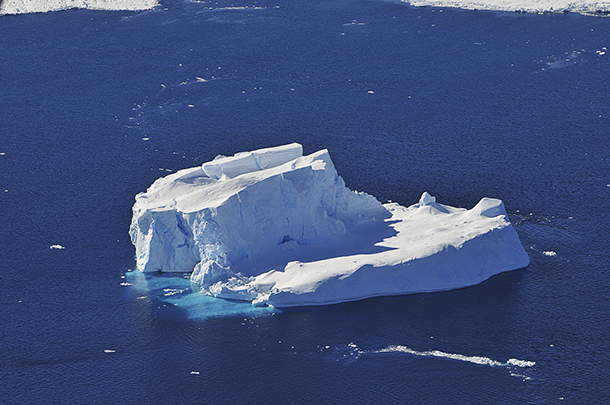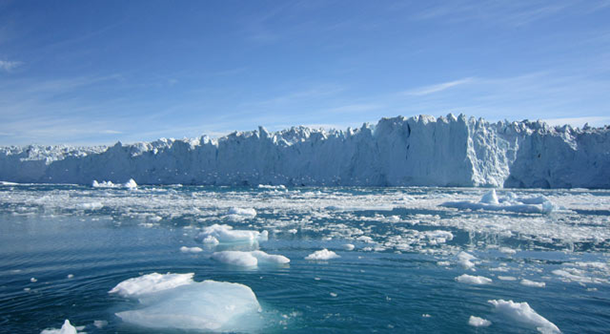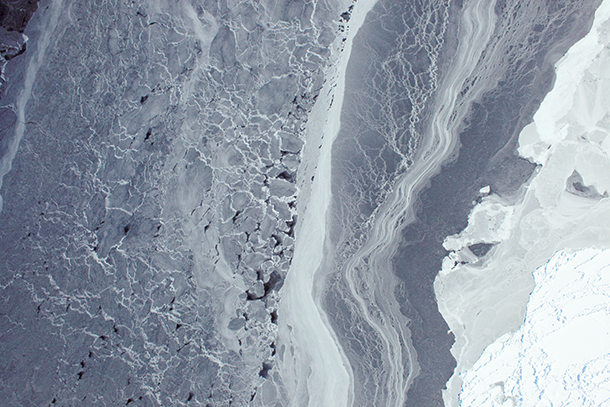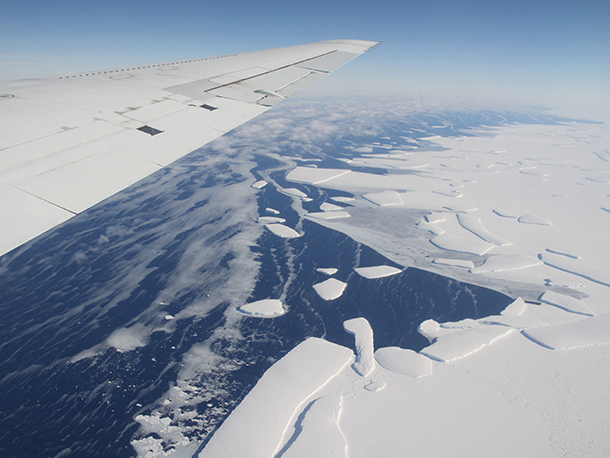The Terrifying Math of Melting Ice Sheets
Air Date: Week of April 8, 2016

An iceberg off the coast of West Antarctica (Photo: NASA, CC BY-NC-ND 2.0)
Recent studies of the physics of ice sheets suggests that we may be vastly underestimating how fast the West Antarctic ice sheet is melting because of global warming. Penn State Climate Scientist Michael Mann tells host Steve Curwood that combined with the melting from other glaciers around the world, seas could rise over six feet by 2100, putting many coastal cities underwater.
Transcript
CURWOOD: From the Jennifer and Ted Stanley studios at the University of Massachusetts Boston and PRI, this is Living on Earth. I’m Steve Curwood. Thanks to human activities, the global warming gas CO2 has reached concentrations not seen for millions of years, back when oceans were 20 to 30 feet higher than today. Until recently many scientists thought it might take hundreds of years for melting ice in Antarctica and Greenland to cause severe sea level rise.
But now new research, including a study led by Rob DeConto, at UMass Amherst, and David Pollard at Penn State, and another led by James Hansen of Columbia, strongly suggest sea levels could rise much faster. We asked Michael Mann, a Professor of Climate Science at Penn State, to put this research in perspective. Welcome back to Living on Earth, Michael.
MANN: Thanks, it's great to be with you.
CURWOOD: So what's new here? We've known about the threat of melting from the West Antarctic ice sheet for long time.
MANN: Well, we've known it's a threat. What has remained rather uncertain is how much and how quickly, and some of these latest studies now have given us quite a bit more information particularly about how rapidly we could potentially lose large parts of the West Antarctic ice sheet.

Store Glacier in West Greenland (Photo: Penn State University, CC BY-NC 2.0)
CURWOOD: Well, how does this paper - your colleagues or Penn State were very much part of this process - how does this paper in nature change our understanding of the mechanics of ice sheet melting.
MANN: So, what the the scientists did actually built on some ideas of another Penn State colleague of mine Richard Alley and it has to do with the geometry of the Western Arctic ice sheet. It's a very large ice sheet, there's a lot of mass in the middle of that ice sheet and because of that downward gravitational force the bedrock actually sags in the middle. What it means is that as ice begins to break away, as the ice shelves begin to decay and expose literally an ice cliff at the edge of the ice sheet where the ice meets the ocean...well, these clips get higher and higher as you lose ice and the cliff penetrates inward towards the center of Antarctica because of the downward sloping nature of that ice sheet, and it turns out that a ice cliff structurally can only be so high before it literally collapses under its own wait and so what happens is these ice cliffs become more and more unstable and you lose ice more and more quickly and that leads to an acceleration in the rate of loss of ice that really hasn't been taken into account in past studies that didn't really resolve some of the important physics here in how ice sheets behave.
CURWOOD: Now, I've heard that the West Antarctica ice sheet is kind of like a boat aground on a shore. How accurate is that analogy and what does that mean. I mean, could the whole thing slip into the water at once?
MANN: It is a good analogy and it's essentially moored. Just like a boat has a mooring, the ice sheet is basically moored where it meets the bedrock and the shelves of the ice sheet are sort of the edges of the ice that literally spill out over the ocean and if you lose those ice shelves they don't actually contribute to sea level rise because they're already floating on the ocean just like an ice cube in a glass of water as it melts doesn't raise the level of the water - it's the same principle. The problem is those ice shelves actually act as buttresses that help prop up the inland ice and when the ocean melts those ice shelves from beneath, inland ice literally begins to calve into the ocean and it's that inland ice sheet it's the ice that is grounded that has the potential to contribute to global sea level rise, so when you melt those ice shelves one of things that happens is that you literally allow the edge of the ice shelf to lift off where it was previously in contact with the bedrock below the surface of the ocean. It's sort of like you've let it unmoored the boat, you've let it free.

West Antarctic Ice Sheet from above (Photo: NASA, CC BY-NC-ND 2.0)
CURWOOD: How much sea level rise we talking about and how soon do you think?
MANN: Well, we probably set in motion already the unstoppable loss, the decay of most of the West Antarctic ice sheet, enough to give us in 10 to 14 feet of sea level rise. What we hoped was the case and what some previous studies had suggested was the case was that it would take many hundreds of years for that to happen, but these past studies didn't really resolve the ice mechanics and the ice physics at the level that this latest study by Pollard and DeConto has done, and what they find is that when you take into account of this instability associated with the ice cliffs, that greatly accelerates the rate at which this can happen to the point where we could probably get the better part of one meter, so more than three feet of sea level rise just from the Western Antarctic ice sheet by 2100. Now, if you look at what the IPCC, the Intergovernmental Panel on Climate Change and their latest report about the state of understanding of climate change, they concluded that we probably wouldn't get much more than about a meter - three feet - of sea level rise by the end of this century. What DeConto and Pollard have included is we may well get a meter of sea level rise - three feet of sea level rise - from the West Antarctic ice sheet alone by 2100. Now if you add in the contribution from the thermal expansion - as water warms it expands and so the warming of the oceans contributes to sea level rise - and we have other glaciers that are also melting and that the water is flowing off into the ocean. If you total up those contributions you get another meter, so the total now is two meters where there's a very good chance we could see two meters of sea level rise by 2100, nearly twice as much as the IPCC concluded just a few years ago.
CURWOOD: What about melting from Greenland? To what extent are the same processes in play there?

West Antarctica by plane (Photo: NASA, CC BY-NC-ND 2.0)
MANN: So the geometry of the situation in Greenland is somewhat different. The Greenland sheet is pretty well contained by the surrounding bedrock of Greenland. It doesn't have large ice shelves spilling out into the ocean like the West Antarctic ice sheet, and because of that this particular instability that is focused upon in this latest study is unlikely to apply to Greenland. That having been said we know that during the last warm interglacial period, 125,000 years ago, before the last Ice Age, when global temperatures were very comparable to what they are now, sea level was probably four to five meters higher. What that suggests is that there was probably a fairly large loss of ice from the West Antarctic ice sheet but there was also probably a contribution from Greenland, so there is the potential that with the warming that we might see you by the end of this century under business as usual burning of fossil fuels we could get another couple meters of sea level rise ultimately from Greenland. Now, that might play out more slowly, but here's the thing...we've been subject to a few surprises already. This latest study by Pollard and DeConto was a bit of a surprise to the community so that's really reason to take some pause. In completely dismissing the possibility that the Greenland ice sheet could indeed melt faster than the models currently projected to. We know from satellite measurements that in fact we are losing more ice from Greenland than the model suggested we were likely to see at this point.
CURWOOD: So this research on the West Antarctic ice sheet adds to what we know about Greenland says that a child born today, in his or her 80s, would see another six feet or more I gather of sea level. What does that mean for coastal cities and infrastructures?
MANN: Well, I'll tell you what it means. Take Hurricane Sandy, Superstorm Sandy. That storm produced a storm surge of about 13 feet at Battery Park in New York City. Global sea level rise was one foot of those 13 feet. The storm surge was 13 feet rather than 12 feet because of global sea level rise. It might sound like a small difference but that one extra foot meant 25 additional square miles of flooding in the New York City metro area of the Jersey coastline. It meant somewhere in the range of $7 billion in additional damage. That's what one foot of global sea level rise does. Imagine what six feet of global sea level rise could do. In fact, we've been doing some work at Penn State and we find that a Sandy-like storm that produces a devastating storm surge in New York City...during the early 20th century that was roughly what we call 100 year event...it shouldn’t have happened any more often than once in 100 years. By the end of the century if we continue with business as usual burning fossil feels, that sort of event will become a one in three year event.

Michael Mann is Distinguished Professor of Atmospheric Science at Penn State University (Photo: Penn State University)
CURWOOD: OK. So you add six feet to 13 feet of a strong hurricane super storm in the New York area and what does that do?
MANN: Right. You know if you add six feet to that 12-foot storm surge, the surge is now an 18-foot storm surge say in 2100. A large part of New York City is below 18 feet. If a storm like that literally becomes a one in three year or one in four event, something like that happens every three to four years then we're exceeding what we call our adaptive capacity, which is to say no amount of sea walls or other adaptations will be able to maintain New York City as a habitable city. We will literally have to retreat from our coastlines. We're talking about the relocation of hundreds of millions of people. You want to talk about an expensive proposition. That's an expensive proposition, so when somebody says it will cost too much to act to reduce our carbon emissions, the fact is the cost of not acting, the damages we'll see if we don't act are far far greater. The good news if there is good news in this latest study by Pollard in DeConto, they argue that there is still time to avoid warming the planet enough to guarantee that scenario of six feet of sea level rise by 2100, but it's a narrow window of time that we have to act, and it's vastly disappearing.
CURWOOD: Michael Mann is a distinguished professor of atmospheric science at Penn State University. Thanks so much for taking the time with us today.
MANN: Thank you, Steve, always a pleasure to talk with you.
Links
Read the new paper in Nature on the West Antarctic Ice Sheet
New paper from CUNY professor Marco Tedesco on melting from Greenland
Living on Earth wants to hear from you!
Living on Earth
62 Calef Highway, Suite 212
Lee, NH 03861
Telephone: 617-287-4121
E-mail: comments@loe.org
Newsletter [Click here]
Donate to Living on Earth!
Living on Earth is an independent media program and relies entirely on contributions from listeners and institutions supporting public service. Please donate now to preserve an independent environmental voice.
NewsletterLiving on Earth offers a weekly delivery of the show's rundown to your mailbox. Sign up for our newsletter today!
 Sailors For The Sea: Be the change you want to sea.
Sailors For The Sea: Be the change you want to sea.
 The Grantham Foundation for the Protection of the Environment: Committed to protecting and improving the health of the global environment.
The Grantham Foundation for the Protection of the Environment: Committed to protecting and improving the health of the global environment.
 Contribute to Living on Earth and receive, as our gift to you, an archival print of one of Mark Seth Lender's extraordinary wildlife photographs. Follow the link to see Mark's current collection of photographs.
Contribute to Living on Earth and receive, as our gift to you, an archival print of one of Mark Seth Lender's extraordinary wildlife photographs. Follow the link to see Mark's current collection of photographs.
 Buy a signed copy of Mark Seth Lender's book Smeagull the Seagull & support Living on Earth
Buy a signed copy of Mark Seth Lender's book Smeagull the Seagull & support Living on Earth

